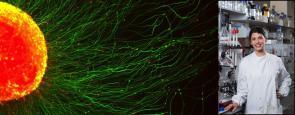Unlike conventional G-protein-coupled receptors (GPCRs), adhesion GPCRs (aGPCRs) have large extracellular regions that are autoproteolytically cleaved from their membrane-embedded seven-pass transmembrane helices. Autoproteolysis occurs within the conserved GPCR-Autoproteolysis INducing (GAIN) domain that is juxtaposed to the transmembrane domain and cleaves the last beta strand of the GAIN domain. The other domains of the extracellular region are variable and specific to each aGPCR and are likely involved in adhering to various ligands. Emerging evidence suggest that extracellular regions may modulate receptor function and that ligand binding to the extracellular regions may induce receptor activation via multiple mechanisms. Here, we summarize current knowledge about the structural understanding for the extracellular regions of aGPCRs and discuss their possible functional roles that emerge from the available structural information.
Cell Membrane
,Animals
,Humans
,Receptors, G-Protein-Coupled
,Ligands
,Cell Adhesion
,Signal Transduction
,Protein Processing, Post-Translational
,Binding Sites
,Protein Binding
,Structure-Activity Relationship
,Models, Molecular
,Protein Interaction Domains and Motifs
,Proteolysis



